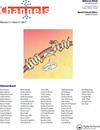Acid-sensing ion channels mediate the degeneration of intervertebral disc via various pathways—A systematic review
IF 3.2
3区 生物学
Q2 BIOCHEMISTRY & MOLECULAR BIOLOGY
引用次数: 7
Abstract
ABSTRACT To elucidate the pathological significance of acid-sensing ion channels (ASICs) in intervertebral disc degeneration (IVDD), the database of Medline, Web of Science, and EmBase were carefully screened. Search terms used in each database varied slightly to optimize results. Data relating to the correlation between ASICs and IVDD was systematically collected and integrated into the review. 11 basic science studies, containing the related information, were finally identified for inclusion. Intervertebral disc degeneration (IVDD) is a common disease in middle-aged and elderly people, which has a great impact on patients’ quality of life. Many research teams have attempted to elucidate the pathogenesis of this degenerative disease, and have made considerable progress. Acid-sensing ion channels (ASICs) were once reported to be able to regulate the apoptosis process of chondrocytes in joint cartilage, which has been transplanted into the IVDD-related research. ASIC1a functions as the mediator for cells in nucleus pulposus (NP) and endplate (EP), with whose activation the apoptosis process would be accelerated. Moreover, ASIC1a’s activation could also regulate the anabolism in chondrocytes of EP, facilitating the degeneration. ASIC3 would only promote the degeneration in NP, possibly via its pro-inflammatory effect. The distribution of ASICs in NP, EP, annulus fibrosus, and the particular functions of ASIC1a and ASIC3 remind us about the pathological significance of ASICs in IVDD, which could be a promising therapeutic target in future treatment for IVDD.酸感离子通道通过多种途径介导椎间盘退变-一项系统综述
为了阐明酸感离子通道(asic)在椎间盘退变(IVDD)中的病理意义,我们对Medline、Web of Science和EmBase数据库进行了仔细筛选。为了优化结果,每个数据库中使用的搜索词略有不同。有关asic和IVDD之间相关性的数据被系统地收集并整合到综述中。包含相关资料的11项基础科学研究最终确定纳入。椎间盘退变(IVDD)是中老年人的常见病,对患者的生活质量影响很大。许多研究小组试图阐明这种退行性疾病的发病机制,并取得了相当大的进展。酸感离子通道(Acid-sensing ion channels, asic)曾被报道能够调控关节软骨中软骨细胞的凋亡过程,并被移植到ivdd的相关研究中。ASIC1a作为髓核(NP)和终板(EP)细胞的介质,其激活会加速细胞凋亡过程。此外,ASIC1a的激活还可以调节EP软骨细胞的合成代谢,促进EP的变性。ASIC3仅促进NP的变性,可能是通过其促炎作用。asic在NP、EP、纤维环中的分布以及ASIC1a和ASIC3的特殊功能提醒我们asic在IVDD中的病理意义,这可能是未来治疗IVDD的一个有希望的治疗靶点。
本文章由计算机程序翻译,如有差异,请以英文原文为准。
求助全文
约1分钟内获得全文
求助全文
来源期刊

Channels
生物-生化与分子生物学
CiteScore
5.90
自引率
0.00%
发文量
21
审稿时长
6-12 weeks
期刊介绍:
Channels is an open access journal for all aspects of ion channel research. The journal publishes high quality papers that shed new light on ion channel and ion transporter/exchanger function, structure, biophysics, pharmacology, and regulation in health and disease.
Channels welcomes interdisciplinary approaches that address ion channel physiology in areas such as neuroscience, cardiovascular sciences, cancer research, endocrinology, and gastroenterology. Our aim is to foster communication among the ion channel and transporter communities and facilitate the advancement of the field.
 求助内容:
求助内容: 应助结果提醒方式:
应助结果提醒方式:


